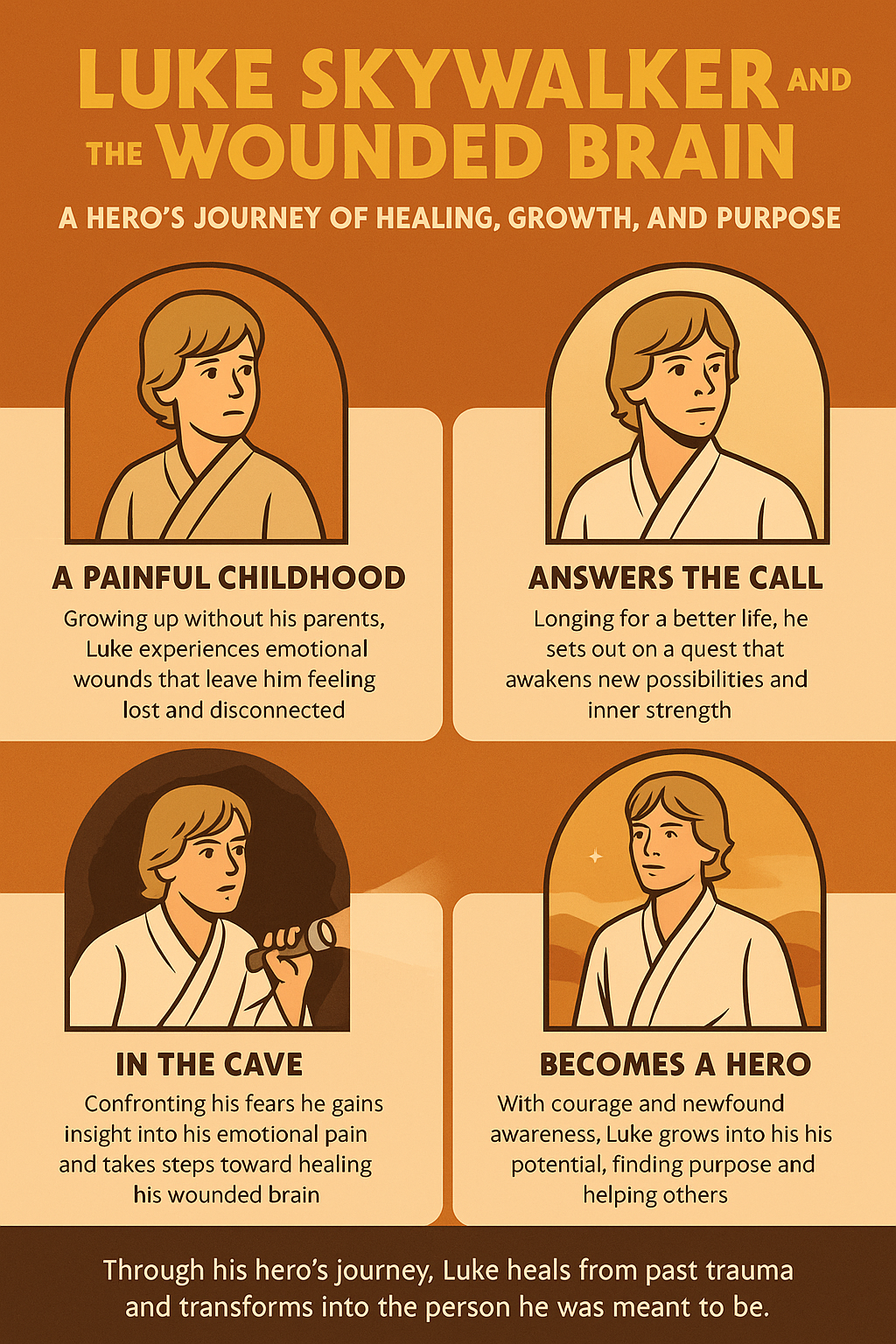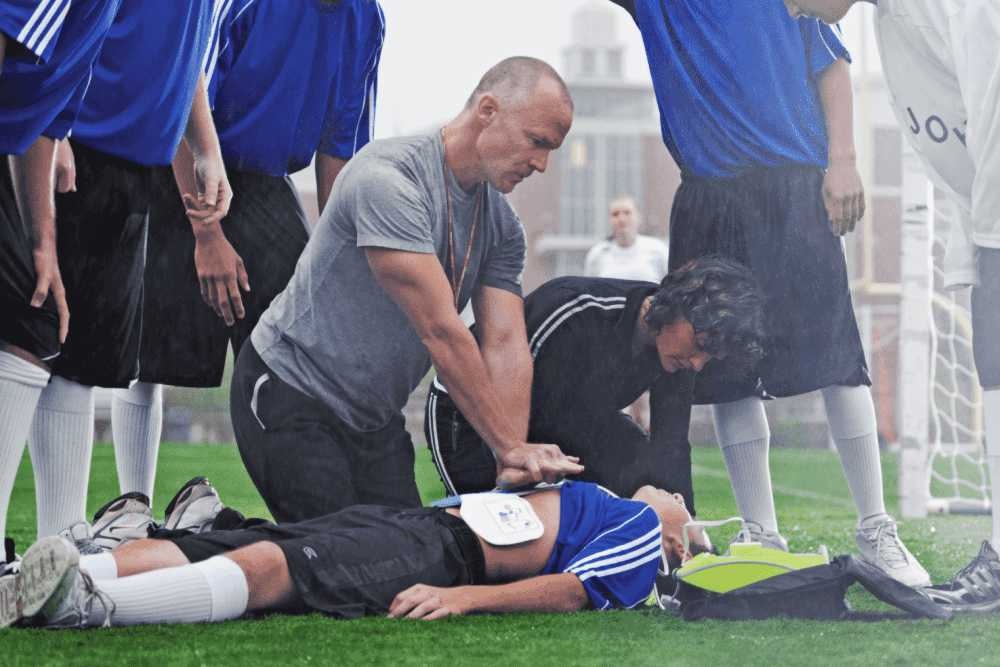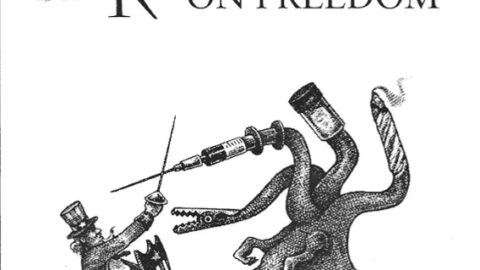Luke Skywalker’s story, though wrapped in the cloak of science fiction and interstellar warfare, is at its core a deeply human journey—a reflection of the psychological path many traumatized individuals walk. His childhood, early emotional challenges, and eventual confrontation with darkness closely mirror the principles outlined in trauma-informed neuroscience, particularly those found in “Rewiring the Wounded Brain” and Joseph Campbell’s Hero’s Journey. Luke’s narrative offers us a symbolic roadmap for healing: from brokenness and fear to self-realization and inner strength.
1. A Childhood Shaped by Absence, Fear, and Suppression
Luke grows up on the remote desert planet of Tatooine under the guardianship of Uncle Owen and Aunt Beru. On the surface, they provide safety and structure, but emotionally, his upbringing is marked by suppression and secrecy. Luke is told little about his origins, denied the truth of his father, and urged to repress any deeper calling within himself. He is constantly told to stay grounded, to stop dreaming, to ignore what he feels inside.
From a trauma-informed lens, this is classic limbic system conditioning. Without understanding the full context of his history, Luke is left with an emotional dissonance—a deep longing and curiosity constantly shut down by those around him. Like many children from homes shaped by fear, secrecy, or unresolved trauma, he grows up emotionally constrained. The neural circuits for adventure, curiosity, emotional depth, and meaning are stunted or shamed.
2. Trauma and Awakening: The Call to Adventure
The pivotal moment in Luke’s psychological awakening is the murder of his aunt and uncle by Imperial troops. This violent rupture mirrors what neuroscientists call a neural shock—a trauma that shatters existing emotional and cognitive patterns. What follows is classic Hero’s Journey: a call to something greater.
From a neuropsychological standpoint, this moment is the break in the pattern that forces Luke to begin rewiring his brain. He no longer has the safety of a predictable life. His nervous system, once trained to suppress emotional truth, is now catapulted into survival, grief, and a desperate search for meaning. The mind begins to re-map.
3. The Cave: Confronting the Shadow Self
One of the most profound metaphors for inner healing comes in The Empire Strikes Back when Luke enters the cave on Dagobah. This sequence is often misunderstood as merely symbolic, but psychologically, it represents Luke entering his limbic system loop—the place where trauma, fear, and emotion are stored.
Inside the cave, he sees himself as Darth Vader. He decapitates his enemy, only to see his own face beneath the mask. This is the moment of confrontation with the inner shadow—a universal step in healing trauma. All individuals must, at some point, face the terrifying possibility that the pain they carry might corrupt or define them.
According to trauma neuroscience, healing requires re-experiencing emotional pain safely, without being overwhelmed by it. The cave offers Luke a simulation—his brain is forced to reckon with the fear that he may become what he hates. In the trauma-informed model, this is a breakthrough: the moment the limbic system is met with both challenge and safety, allowing new neural pathways of awareness, regulation, and insight to form.
4. Mentorship and Safe Relationships: The Role of Yoda and Obi-Wan
No one rewires a wounded brain alone. For Luke, healing is deeply intertwined with the guidance of Obi-Wan Kenobi and Master Yoda. These mentors act as emotional regulators, offering relational stability and experiential wisdom that reshape Luke’s sense of self.
Just as trauma-informed care emphasizes the power of consistent, safe, and responsive relationships in healing childhood trauma, Luke’s transformation is only possible because of the Jedi Masters who see him not as what he was but as what he can become.
Their belief in him, their structure and discipline, and their willingness to challenge him all form a reparative emotional framework. It’s within these relationships that Luke begins to form a healthy prefrontal-limbic dialogue: emotion integrated with reason, power tempered with compassion.
5. The Temptation of the Dark Side: Trauma’s Lure Toward Control
When Luke faces the Emperor and Darth Vader in Return of the Jedi, he is not just fighting evil figures. He is fighting the unresolved trauma within himself. The dark side offers what trauma survivors crave: control, power, escape from vulnerability. The Emperor tempts Luke by appealing to his anger, his grief, and his desire for revenge—all emotional energies born in the limbic system.
But Luke resists. Not because he is emotionless, but because he has learned emotional mastery. He throws away his lightsaber—choosing love, mercy, and restraint over domination. This moment marks the full integration of the wounded brain. Luke has entered the cave, faced his shadow, emerged stronger, and now reclaims his agency from the cycle of fear and reactivity.
6. A New Man, A New Mind: The Neurobiology of Healing
By the end of his journey, Luke is no longer a boy driven by longing and confusion. He is a man of peace, purpose, and resilience. His brain has quite literally changed. This is the process described in trauma research as neuroplasticity—the brain’s ability to heal by building new experiences that outweigh the traumatic associations.
Through love, loss, fear, failure, perseverance, connection, and truth, Luke Skywalker becomes the embodiment of the healed hero. He reminds us that:
- Trauma may define your start, but not your finish.
- Healing requires both solitude and support.
- Real strength is emotional maturity, not domination.
- The cave, the shadow, and the fear must be faced.
- The greatest power is the capacity to feel deeply and still choose the good.
Conclusion: The Cave Is the Key
Luke Skywalker’s journey is not just about Jedi powers or galactic battles—it is a profound reflection of the human struggle to integrate pain, reclaim identity, and live a life of truth. He is the orphan who becomes the guardian, the wounded boy who becomes a healer, the reactive soul who becomes a wise teacher.
And that is the lesson for all who walk the path of trauma recovery: the cave you fear to enter holds the treasure you seek.
Let Luke’s story remind us—our fears do not make us weak, but facing them makes us whole.






